 полная версия
полная версияStained Glass Work: A text-book for students and workers in glass
What Tools are wanted to complete the Outline.—I will now describe those tools which you want at this stage, that is, to mend your outline with.
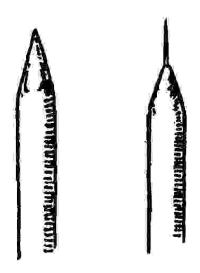
Fig. 24.
You want the brush which you used in the first instance to paint it with, and that has already been described; but you also want points of various fineness to etch it away with where it is too thick; these are the needle and the stick (fig. 24); any needle set in a handle will do, but if you want it for fine work, take care that it be sharp. "How foolish," you say; "as if you need tell us that." On the contrary,—nine people out of ten need telling, because they go upon the assumption that a needle must be sharp, "as sharp as a needle," and cannot need sharpening,—and they will go on for 365 days in a year wondering why a needle (which must be sharp) should take out so much coarser a light than they want.
Now as to "sticks"; if you make a point of soft wood it lasts for three or four touches and then gets "furred" at the point, and if of very hard wood it slips on the glass. Bamboo is good; but the best of all—that is to say for broad stick-lights—is an old, sable oil-colour brush, clogged with oil and varnish till it is as hard as horn and then cut to a point; this "clings" a little as it goes over the glass, and is most comfortable to use.
I have no doubt that other materials may be equally good, celluloid or horn, for example; the student must use his own ingenuity on such a simple matter.
How to Complete the Outline.—With the tools above described complete the outline—by adding colour with the brush where the lines are too fine, and by taking it away with needle or stick where they are too coarse; make it by these means exactly like the copy, and this is all you need do. But as an example of the degree of correctness attainable (and therefore to be demanded) are here inserted two illustrations (figs. 25 and 26), one of the example used, and the other of a copy made from it by a young apprentice.
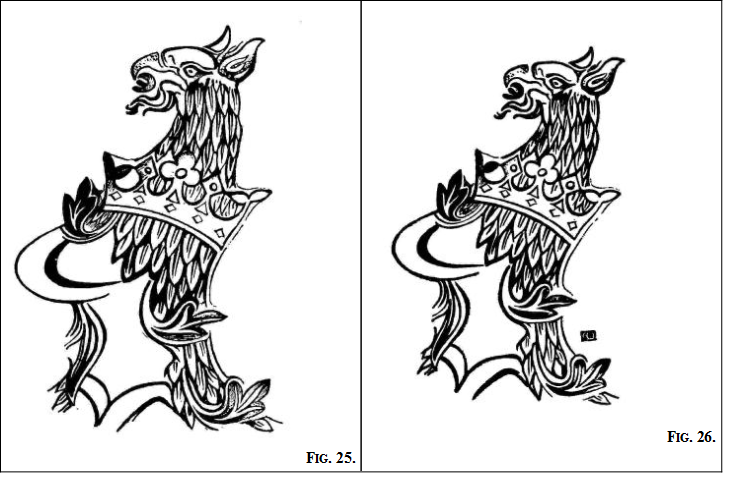
CHAPTER IV
Matting—Badgering—How to preserve Correctness of Outline—Difficulty of Large Work—Ill-ground Pigment—The Muller—Overground Pigment—Taking out Lights—"Scrubs"—The Need of a Master.
Take your camel hair matting-brush (fig. 27 or 28); fill it with the pigment, try it on the slab of the easel till it seems just so full that the wash you put on will not run down till you have plenty of time to brush it flat with the badger (fig. 29).
Have your badger ready at hand and very clean, for if there is any pigment on it from former using, that will spoil the very delicate operation you are now to perform.
Now rapidly, but with a very light hand, lay an even wash over the whole piece of glass on which the outline is painted; use vertical strokes, and try to get the touches to just meet each other without overlapping; but there is a very important thing to observe in holding the brush. If you hold it so (fig. 30) you cannot properly regulate the pressure, and also the pigment runs away downwards, and the brush gets dry at the point; you must hold it so (fig. 31), then the curve of the hair makes the brush go lightly over the surface, while also, the body of the brush being pointed downwards, the point you are using is always being refilled.
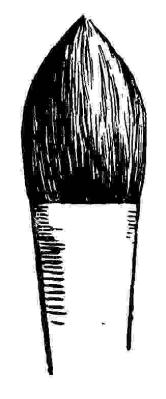
Fig. 27.

Fig. 28.

Fig. 29.
It takes a very skilful workman indeed to put the strokes so evenly side by side that the result looks flat and not stripy; indeed you can hardly hope to do so, but you can get rid of what "stripes" there are by taking your badger and "stabbing" the surface of the painting with it very rapidly, moving it from side to side so as never to stab twice in the same spot; this by degrees makes the colour even, by taking a little off the dark part and putting it on the light; but the result will look mottled, not flat and smooth. Sometimes this may be agreeable, it depends on what you are painting; but if you wish it to be smooth, just give a last stroke or two over the whole glass sideways, that is to say, holding the badger so that it stands quite perpendicular to the glass, move it, always still perpendicular, across the whole surface. You must not sway it from side to side, or kick it up at the end of each stroke like a man white-washing; it must move along so that the points of the hairs are all just lightly touching the glass all the time.
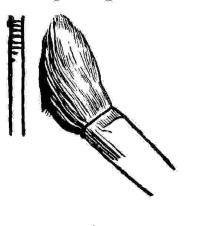
Fig. 30.
How to Ensure the Drawing of a Face being kept Correct while Painting.—If you adopt the plan of doing the first painting over an unfired outline, you must be very careful that the outline is not brushed out of drawing in the process. If you have sufficient skill it need not be so, for it is quite possible—if all the conditions as to adhesiveness are right—and if you are light-handed enough—to so lay and badger the "matt" that the outline beneath shall only be gently softened, and not blurred or moved from its place. But in any case the best plan is at the same time that you trace the outline of a head on to the glass to trace it also with equal care on to a piece of tracing paper, and arrange three or four well-marked points, such as the corner of the mouth, the pupil of the eye, and some point on the back of the head or neck, so that these cannot possibly shift, and that you may be able at any time to get the tracing back into its proper place, both on the cartoon and on the piece of glass on which you are to paint the head. On which piece of glass also your first care should be that these three or four points should be clearly marked and unmovable; then during the whole progress of the painting you will always be able to verify the correctness of the drawing by placing your piece of tracing paper over the glass, and so seeing that nothing has shifted its place.
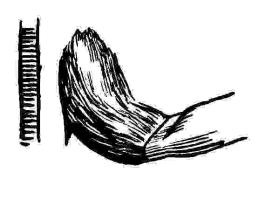
Fig. 31.
It requires a good deal of patience and practice to lay matt successfully over unfired outline. It is a question of the amount and quality of the gum, the condition of your brush, even the dryness or dampness of the air. You must try what degree of gum suits you best, both in the outline and in the matt which you are to pass over it. Try it a good many times on a slab of plain glass or on the plate of your easel first, before you try on your painting. Of course it's a much easier thing to matt successfully over a small piece than over a large. A head as big as the palm of your hand is not a very severe test of your powers; but in one as large as the whole of your hand, say a head seven inches from crown to chin, the problem is increased quite immeasurably in difficulty. The real test is being able to produce in glass a real facsimile of a head by Botticelli or Holbein, and when you can do that satisfactorily you can do anything in glass-painting.
Do not aim to get too much in the first painting, at any rate not till you have had long practice. Be content if you get enough modelling on a head to turn the outline into a more sensitive and artistic drawing than it could be if planted down, raw and hard, upon the bare, cold glass. After all it is a common practice to fire the outline separately, and anything beyond this that you get upon the glass for first fire is so much to the good.
But besides the quality of the gum you will find sometimes differences in the quality or condition of the pigment. It may be insufficiently ground; in which case the matt, in passing over, will rasp away every vestige of the outline, so delicate a matter it is.
You can tell when colour is not ground sufficiently by the way it acts when laid as a vertical wash. Lay a wash, moist enough to "run," on a bit of your easel-slab; it will run down, making a sort of seaweed-looking pattern—clear lanes of light on the glass with a black grain at the lower end. Those are the bits of unground material: under a 100-diameter microscope they look like chunks of ironstone or road metal, or of rusty iron, and you'll soon understand why they have scratched away your tender outline.
You must grind such colour till it is smooth, and an old-fashioned granite muller is the thing, not a glass one.
Now, after all this, how am I to excuse the paradox that it is possible to have the colour ground too fine! All one can say is that you "find it so." It can be so fine that it seems to slip about in a thin, oily kind of way.
It's all as you find it; the differences of a craft are endless; there is no forecasting of everything, and you must buy your experience, like everybody else, and find what suits you, learning your skill and your materials side by side.
Now these are the chief processes of painting, as far as laying on colour goes; but you still have much of your work before you, for the way in which light and shade is got on glass is almost more in "taking off" than in "putting on." You have laid your dark "matt" all over the glass evenly; now the next thing is to remove it wherever you want light or half-tone.
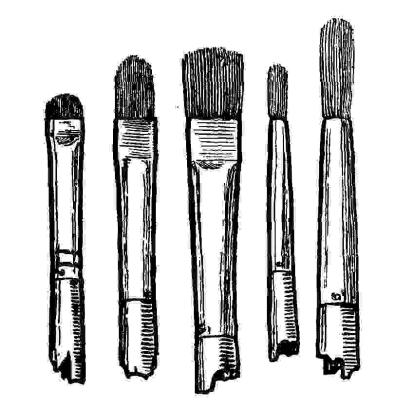
Fig. 32.
How to Finish a Shaded Painting out of the Even Matt.—This is done in many ways, but chiefly with those tools which painters call "scrubs," which are oil-colour hog-hair brushes, either worn down by use, or rubbed down on fine sandpaper till they are as stiff as you like them to be. You want them different in this: some harder, some softer; some round, some square, and of various sizes (figs. 32 and 33), and with these you brush the matt away gently and by degrees, and so make a light and shade drawing of it. It is exactly like the process of mezzotint, where, after a surface like that of a file has been laboriously produced over the whole copper-plate, the engraver removes it in various degrees, leaving the original to stand entirely only for the darkest of all shadows, and removing it all entirely only in the highest lights.
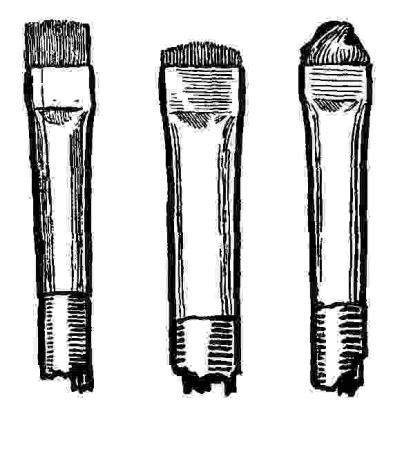
Fig. 33.
There is nothing for this but practice; there is nothing more to tell about it; as the conjurers say, "That's how it's done." You will find difficulties, and as these occur you will think this a most defective book. "Why on earth," you will say, "didn't he tell us about this, about that, about the other?" Ah, yes! it is a most defective book; if it were not, I would have taken good care not to write it. For the worst thing that could happen to you would be to suppose that any book can possibly teach you any craft, and take the place of a master on the one hand, and of years of practice on the other.
This book is not intended to do so; it is written to give as much information and to arouse as much interest as a book can; with the hope that if any are in a position to wish to learn this craft, and have not been brought up to it, they may learn, in general, what its conditions are, and then be able to decide whether to carry it further by seeking good teaching, and by laying themselves out for a patient course of study and practice and many failures and experiments. While, with regard to those already engaged in glass-painting, it is of course intended to arouse their interest in, and to give them information upon, those other branches of their craft which are not generally taught to those brought up as glass-painters.
CHAPTER V
Cutting (advanced)—The Ideal Cartoon—The Cut-line—Setting the Cartoon—Transferring the Cut-line to the Glass—Another Way—Some Principles of Taste—Countercharging.
We have only as yet spoken of the processes of cutting and painting in themselves, and as they can be practised on a single bit of glass; but now we must consider them as applied to a subject in glass where many pieces must be used. This is a different matter indeed, and brings in all the questions of taste and judgment which make the difference between a good window and an inferior one. Now, first, you must know that every differently coloured piece must be cut out by itself, and therefore must have a strip of lead round it to join it to the others.
Draw a cartoon of a figure, bearing this well in mind: you must draw it in such a simple and severe way that you do not set impossible or needlessly difficult tasks to the cutter. Look now, for example, at the picture in Plate V. by Mr. Selwyn Image—how simple the cutting!
You think it, perhaps, too "severe"? You do not like to see the leads so plainly. You would like better something more after the "Munich" school, where the lead line is disguised or circumvented. If so, my lesson has gone wrong; but we must try and get it right.
You would like it better because it is "more of a picture"; exactly, but you ought to like the other better because it is "more of a window." Yes, even if all else were equal, you ought to like it better, because the lead lines cut it up. Keep your pictures for the walls and your windows for the holes in them.
But all else is not equal: and, supposing you now standing before a window of the kind I speak of, I will tell you what has been sacrificed to get this "picture-window" "like a picture." Stained-glass has been sacrificed; for this is not stained-glass, it is painted glass—that is to say, it is coloured glass ground up into powders and painted on to white sheets of glass: a poor, miserable substitute for the glorious colour of the deep amethyst and ruby-coloured glasses which it pretends to ape. You will not be in much danger of using it when you have handled your stained-glass samples for a while and learned to love them. You will love them so much that you will even get to like the severe lead line which announces them for what they are.
But you must get to reasonably love it as a craft limitation, a necessity, a thing which places bounds and limits to what you can do in this art, and prevents tempting and specious tricks.
How to Make a "Cut-line."—But now, all this being granted, how are we to set about getting the pieces cut? First of all, I would say that it is always well to draw most, if not all, of the necessary lead lines on the cartoon itself. By the necessary lead lines I mean those which separate different colours; for you know that there must be a lead line between these. Then, when these are drawn, it is a question of convenience whether to draw in also the more or less optional lead lines which break up each space of uniform colour into convenient-sized pieces. If you do not want your cartoon afterwards for any other purpose you may as well do so: that is, first "set" the cartoon if it is in charcoal or chalk, and then try the places for these lead lines lightly in charcoal over the drawing: working thus, you can dust them away time after time till they seem right to you, and then either set them also or not as you choose.
A good, useful setting-mixture for large quantities is composed by mixing equal parts of "white polish" and methylated spirit; allowing it to settle for a week, and pouring off all that is clear. It is used in the ordinary way with a spray diffuser, and will keep for any length of time.
The next step is to make what is called the cut-line. To do this, pin a piece of tracing-cloth over the whole cartoon; this can be got from any artist's-colourman or large stationer. Pin it over the cartoon with the dull surface outwards, and with a soft piece of charcoal draw lines 1/16 to 1/8 of an inch wide down the centre of all the lead lines: remove the cloth from the cartoon, and if any of the lines look awkward or ugly, now that you see them by themselves undisguised by the drawing below, alter them, and then, finally, with a long, thin brush paint them in, over the charcoal, with water-colour lamp-black, this time a true sixteenth of an inch wide. Don't dust the charcoal off first, it makes the paint cling much better to the shiny cloth.
When this is done, there is a choice of three ways for cutting the glass. One is to make shaped pieces of cartridge-paper as patterns to cut each bit of glass by; another is to place the bits of glass, one by one, over the cut-line and cut freehand by the line you see through the glass. This latter process needs no description, but you cannot employ it for dark glasses because you cannot see the line through: for this you must employ one of the other methods.
How to Transfer the Cutting-line on to the Glass.—Take a bit of glass large enough to cut the piece you want; place it, face upwards, on the table; place the cut-line over it in its proper place, and then slip between them, without moving either, a piece of black "transfer paper": then, with a style or hard pencil, trace the cutting-line down on to the glass. This will not make a black mark visible on the glass, it will only make a grease mark, and that hardly visible, not enough to cut by; but take a soft dabber—a lump of cotton-wool tied up in a bit of old handkerchief—and with this, dipped in dry whitening or powdered white chalk, dab the glass all over; then blow the surface and you will see a clear white line where the whitening has stuck to the greasy line made by the transfer paper; and by this you can cut very comfortably.
But a third way is to cut the shape of each piece of glass out in cartridge-paper; and to do this you put the cut-line down over a sheet of "continuous-cartridge" or "cartoon" paper, as it is called, and press along all the lines with a style or hard pencil, so as to make a furrow on the paper beneath; then, after removing the cut-line, you place a sheet of ordinary window-glass below the paper and cut out each piece, between the "furrows" leaving a full 1/16 of an inch. This sixteenth of an inch represents the "heart" or core of the future lead; it is the distance which the actual bits of glass lie one from the other in the window. You must use a very sharp penknife, and you will find that, cutting against glass, each shape will have quite a smooth edge; and round this you can cut with your diamond.
This method, which is far the most accurate and craftsmanly way of cutting glass, is best used with the actual diamond: in that case you feel the edge of the paper all the time with the diamond-spark; but in cutting with the wheel you must not rest against the edge of the paper; otherwise you will be sure to cut into it. Now, whichever of all these processes you employ, remember that there must be a full 1/16 of an inch left between each piece of glass and all its neighbours.
The reason why you leave this space between the pieces is that the core of the lead is about that or a little less in thickness: the closer the glass fits to this the better, but no part of the glass must go nearer to its neighbour than this, otherwise the work will be pressed outwards, and you will not be able to get the whole of the panel within its proper limits.
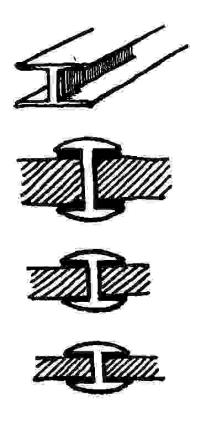
Fig. 34.
Fig. 34 is an illustration of various kinds and sizes of lead; showing some with the glass inserted in its place. By all means make your leads yourself, for many of those ready made are not lead at all, or not pure lead. Get the parings of sheet lead from a source you can trust, and cast them roughly in moulds as at fig. 35. Fig. 36 is the shears by which the strips may be cut; fig. 37 is the lead-mill or "vice" by which they are milled and run into their final shape; fig. 38 the "cheeks" or blocks through which the lead passes. The working of such an instrument is a thing that is understood in a few minutes with the instrument itself at hand, but it is cumbrous to explain in writing, and not worth while; since if you purchase such a thing, obviously the seller will be there to explain its use. Briefly,—the handle turns two wheels with milled edges 1/16 of an inch apart; which, at one motion, draw the lead between them, mill it, and force it between the two "cheeks" (fig. 38), which mould the outside of the lead in its passage. These combined movements, by a continuous pressure, squeeze out the strip of lead into about twice its length; correspondingly decreasing its thickness and finishing it as it goes.
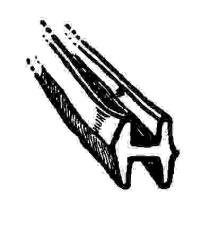
Fig. 35.
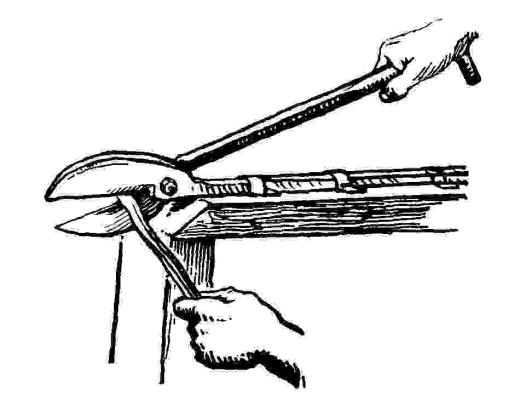
Fig. 36.
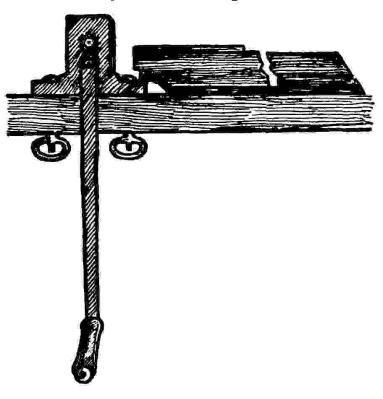
Fig. 37.
Some principles of good taste and common sense with regard to the cutting up of a Window; according to which the Cartoon and Design must be modified.—Never disguise the lead line. Cut the necessary parts first, as I said before; cut the optional parts simply; thinking most of craft-convenience, and not much of realism.
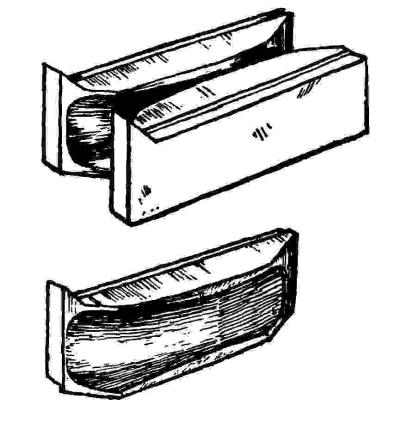
Fig. 38.
Do not, however, go to the extent of making two lead lines cross each other. Fig. 39 shows the two kinds of joint, A being the wrong one (as I hold), and B the right one; but, after all, this is partly a question of taste.
Do not cut borders and other minor details into measured spaces; cut them hap-hazard.

Fig. 39.
Do not cut leafage too much by the outlines of the groups of leaves—or wings by the outlines of the groups of feathers.
Do not outline with lead lines any forms of minor importance.
Do not allow the whole of any figure to cut out dark against light, or light against dark; but if the figure is ever so bright, let an inch or two of its outline tell out as a dark against a spot of still brighter light; and if it is ever so dark, be it red or blue as strong as may be, let an inch or two of its outline tell out against a still stronger dark in the background, if you have to paint it pitch-black to do so.
By this "countercharging" (as heralds say), your composition will melt together with a pleasing mystery; for you must always remember that a window is, after all, only a window, it is not the church, and nothing in it should stare out at you so that you cannot get away from it; windows should "dream," and should be so treated as to look like what they are, the apertures to admit the light; subjects painted on a thin and brittle film, hung in mid-air between the light and the dark.
CHAPTER VI
Painting (advanced)—Waxing-up—Cleanliness—Further Methods of Painting—Stipple—Dry Stipple—Film—Effects of Distance—Danger of Over-Painting—Frying.
I have mentioned all these points of judgment and good taste we have just finished speaking of, because they are matters that must necessarily come before you at the time you are making the cartoon, the preliminary drawing of the window, and before you come to handle the glass at all.
But it is now necessary to tell you how the whole of the glass, when it is cut, must be fixed together, so that you can both see it and paint upon it as a whole picture. This is done as follows:—

